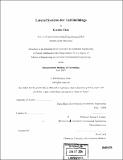| dc.contributor.advisor | Jerome J. Connor. | en_US |
| dc.contributor.author | Chok, Kermin, 1980- | en_US |
| dc.contributor.other | Massachusetts Institute of Technology. Dept. of Civil and Environmental Engineering. | en_US |
| dc.date.accessioned | 2006-03-24T18:22:48Z | |
| dc.date.available | 2006-03-24T18:22:48Z | |
| dc.date.copyright | 2004 | en_US |
| dc.date.issued | 2004 | en_US |
| dc.identifier.uri | http://hdl.handle.net/1721.1/30135 | |
| dc.description | Thesis (M. Eng.)--Massachusetts Institute of Technology, Dept. of Civil and Environmental Engineering, 2004. | en_US |
| dc.description | Includes bibliographical references. | en_US |
| dc.description.abstract | The advances in three-dimensional structural analysis and computing resources have allowed the efficient and safe design of increasingly taller structures. These structures are the consequence of increasing urban densification and economic viability. The modern skyscraper has and will thus continue to feature prominently in the landscape of urban cities. The trend towards progressively taller structures has demanded a shift from the traditional strength based design approach of buildings to a focus on constraining the overall motion of the structure. Structural engineers have responded to this challenge of lateral control with a myriad of systems that achieve motion control while adhering to the overall architectural vision. An investigation was carried out to understand the behavior of the different lateral systems employed in today's skyscrapers. The investigation examined the structural behavior of the traditional moment frame, the braced frame, the braced frame with outriggers and finally the tubular structure. The advantages and disadvantages of all schemes were explored from both an architectural and structural efficiency standpoint. Prior to the computer modeling of each lateral system, each scheme was understood from an analytical standpoint to both verify computer results and to illustrate the importance of hand calculations. The study repeatedly illustrated that motion was the governing condition and this led to the proposal of an approach for the design of braced frames. | en_US |
| dc.description.statementofresponsibility | by Kermin Chok. | en_US |
| dc.format.extent | 198 p. | en_US |
| dc.format.extent | 5395488 bytes | |
| dc.format.extent | 5395297 bytes | |
| dc.format.mimetype | application/pdf | |
| dc.format.mimetype | application/pdf | |
| dc.language.iso | eng | en_US |
| dc.publisher | Massachusetts Institute of Technology | en_US |
| dc.rights | M.I.T. theses are protected by copyright. They may be viewed from this source for any purpose, but reproduction or distribution in any format is prohibited without written permission. See provided URL for inquiries about permission. | en_US |
| dc.rights.uri | http://dspace.mit.edu/handle/1721.1/7582 | |
| dc.subject | Civil and Environmental Engineering. | en_US |
| dc.title | Lateral systems for tall buildings | en_US |
| dc.type | Thesis | en_US |
| dc.description.degree | M.Eng. | en_US |
| dc.contributor.department | Massachusetts Institute of Technology. Department of Civil and Environmental Engineering | |
| dc.identifier.oclc | 56016285 | en_US |
